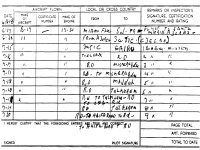Aliyah Bet & Machal Virtual Museum
North American Volunteers In Israel's War of Independence
Pictorial History: Air Force Volunteers
Only a handful of Palestinian Jews had military pilot training. Veterans from World War II – primarily from the U.S., Canada, England and South Africa – manned the hodgepodge of German, American and British aircraft to stop the Arab air and ground attacks.
Since England would not admit Palestinian Jews into the Royal Air Force for aircrew training until 1943, pilots, navigators and other flying personnel with military experience were in short supply. Israel turned to the Diaspora – primarily to the U.S., Canada, England, and South Africa – for veteran flying crews who could help stop the Arab invasion on the ground and in the air. More than half of all American and Canadian volunteers served in the air force.
Eddy Kaplansky, an authority on the IAF during the 1948-49 war, concluded: “It is generally accepted that without Machal the nascent IAF would not have been able to fly its heavy bombers and transport planes, nor could it have wrested control of the skies from enemy air forces. It may well be, therefore, that the participation of Machal in the IAF is what tipped the scales in Israel’s favor in the War of Independence, whose outcome hung precariously in the balance.”

Group of men in front of B-17


German/Czech Me-109

Rudy Augarten

Spitfire

Flight Log

Ray Kurtz

Bill Lichtman

Row of Norseman aircraft


Cub Bomber



Curtis-Wright C-46 Commando

Harold Auerbach
A little-known story of the Arab-Israeli war of 1948 involved American planes, mostly-American pilots and the decision of one small country to help another.
After approval of the Partition Plan in November 1947, England continued to supply weapons and ammunition to its client-states Egypt and Trans-Jordan. But virtually the entire world imposed an embargo on sale and shipment of military equipment to Israel-except Czechoslovakia, which agreed to sell a substantial amount of German-designed rifles, machineguns, ammunition, and even fighter planes to the Jewish state
But Czechoslovakia was land-locked, surrounded by countries that would not allow transshipment of arms in violation of the embargo, and more than 1,800 miles from Israel. With a chartered C-54 and seven of the C-46s originally purchased as war surplus in California, Machal pilots and crews in the Israeli Air Force Air Transport Command began an airlift that would become one of the miracles of the War of Independence.

1,800 very, very tough miles, Zatec, Czechoslovakia, to Israel.


C-46 over Haifa Bay

Eddy Kaplansky

 Back to An English-Speaking Air Force
Back to An English-Speaking Air Force